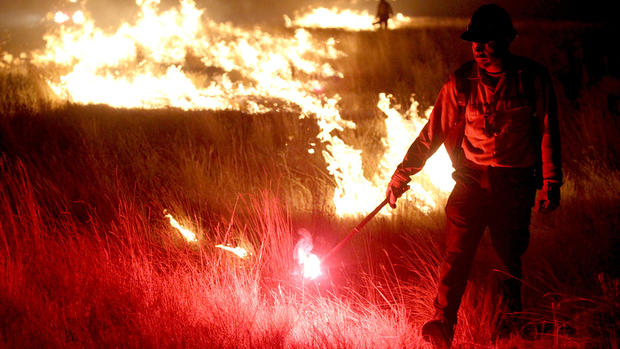Aggressive fire suppression leaves West a tinderbox, making mega-fires worse
(CBS News) Dry conditions are dangerous in this season of devastating wildfires. Twenty-one large fires are burning across the West. None are as bad as the recent Waldo Canyon fire in Colorado, which left two people dead and burned 346 homes.
Fires this destructive -- or so fierce that they can't be contained -- are called mega-fires. And we're seeing more of them. Drought and climate change are big contributors -- but there is one factor that we've brought upon ourselves.
A small army of high school students took to the hills recently in southern Montana. Armed with simple garden tools, they cleared away decades of fallen trees and brush from a nine-acre site
The major problem for many Western forests is what's building up on the ground: tons of downed, dead debris, and small trees. Under natural conditions, fires would have come through and burned the debris.
But now, because people live in the forest, we don't want fire. In our eagerness to suppress the fires, the debris builds up -- and it builds up to the point that when you do have a fire, it becomes catastrophic.
Fire ecologist Nathan Korb of the Nature Conservancy says the long-standing Forest Service policy of fighting every fire has escalated the risk.
"We are managing for mega-fires," Korb said. "We are creating the conditions that will support mega-fires that are guaranteed to destroy homes and kill people."
Historically, natural, smoldering fires thinned the forest floor every 15 to 20 years. But with the accumulated brush, those fires burn much more intensely -- so hot, that the very treetops can sometimes ignite, causing giant plumes of smoke and exploding fires that can leap great distances.
In Montana, we met the 20-member Lewis and Clark hotshot firefighters. They helped put out a 4,800-acre blaze near the town of Mammoth.
Rob Pentzer, a fire warden for the Craig Mountain Forest Protection District with the Idaho Department of Lands, says people and property directly in harm's way have forced firefighters to alter their tactics.
"If we were just going to fight the fire, that's simple, relatively," he said. "But when you put life and property as one of your no. 1 objectives, you have to take care of those things first before you can fight the fire."
The Forest Service has a new $40 million program to clear over 4 million acres of built-up debris, although as much as 87 million acres needs treatment. many ecologists would like to see more controlled burns -- fires intentionally set and monitored that mimics those historic fires.
So why doesn't that happen more often?
"It has to do with politics," Pentzer said. "You have the recreation people, the fishery people, the wildlife people, the forestry people -- you know, go on and on and on. All these people have to come together and agree before anything can get done on the ground."
Despite those risks, people continue to build homes in fire danger areas.
A recent report showed one in four Colorado homes is located in a fire zone. A quarter million people have moved into the so-called "red zone" in the past two decades -- 100,000 of them since the state's largest wildfire 10 years ago.
And the 4 million acres the Forest Service is targeting for treatment is just a drop in the bucket. Between 64 and 87 million acres are currently at risk of catastrophic fire.
